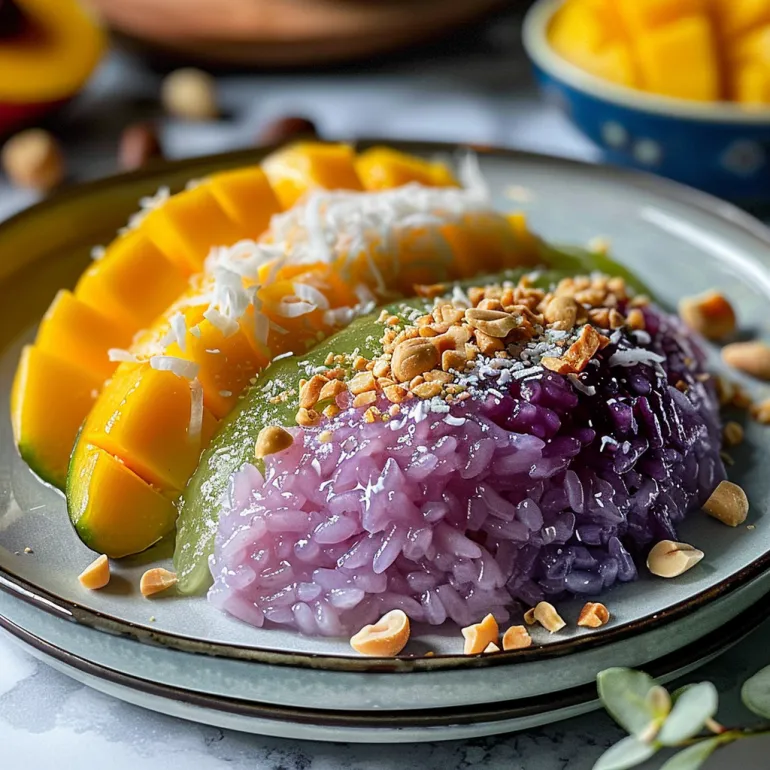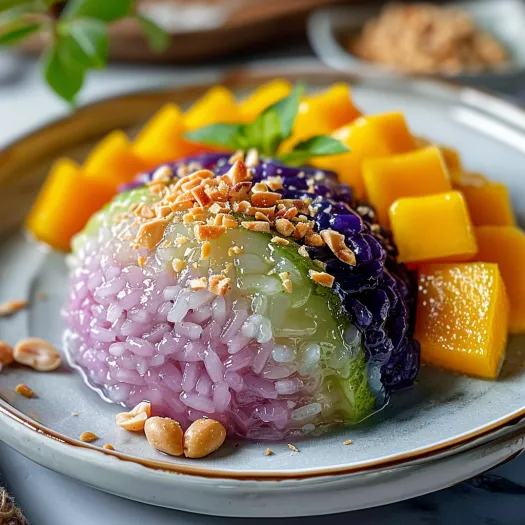 Pin
Pin
This Thai mango sticky rice recipe brings together sweet tropical mangoes and creamy coconut-infused sticky rice to make a dessert that feels like a vacation in every forkful. With just a handful of ingredients and simple steps, you can recreate this beloved Thai street food classic at home. I reach for it every summer when mangoes are at their best and my friends always ask for seconds.
Once I served this to friends who had never traveled to Southeast Asia and they could not believe the taste was so authentic and fresh. Now every year when mango season comes around this is my go-to treat.
Ingredients
- Glutinous sticky rice: Essential for chewy texture Look for packages labeled sweet rice or glutinous rice at Asian grocery stores
- Full-fat coconut milk: This makes the sauce luxurious and thick Choose a brand with no added gums and shake well before using
- Ripe mangoes: The main star Choose yellow-skinned varieties like Ataulfo or Nam Dok Mai for maximum sweetness and aroma
- Granulated sugar: Sweetens both the sauce and rice Use organic or superfine sugar for quickest dissolving
- Salt: Balances the sweetness and sharpens flavors Use fine sea salt for even mixing
- Optional sesame seeds or mung beans: Add crunch and nutty flavor Toast lightly before sprinkling if you use these
Step-by-Step Instructions
- Soak the Rice:
- Rinse the sticky rice thoroughly under cool water until the water runs mostly clear This removes excess starch and keeps the rice from becoming gummy Transfer to a bowl and cover with plenty of water Let it soak for at least four hours or up to overnight The longer it soaks the more evenly it will cook
- Steam the Rice:
- Drain the soaked rice and spread it in a thin even layer in a steamer basket lined with cheesecloth Set the basket over rapidly simmering water and cover tightly Steam for twenty five minutes checking after fifteen minutes and fluffing with a fork if needed The grains should be plump and sticky but not mushy
- Prepare the Coconut Sauce:
- Pour coconut milk sugar and salt into a small saucepan Set over low heat and stir gently until the sugar and salt dissolve completely Do not let the mixture boil Stirring constantly helps prevent the coconut from separating
- Combine Rice and Sauce:
- Scrape the hot cooked rice into a mixing bowl and pour over half the warm coconut sauce Stir gently but thoroughly to coat all the grains Cover the bowl with a lid or plastic wrap and let sit for fifteen minutes The rice will absorb the sauce and turn glossy and fragrant
- Plate and Serve:
- Scoop the sticky rice onto a serving plate or shallow bowl Use wet hands or a spatula to keep the rice from sticking Fan out the sliced mangoes attractively alongside the rice Drizzle generously with the remaining coconut sauce and finish with a sprinkle of sesame seeds or mung beans for a bit of crunch
 Pin
Pin
I always insist on using silky yellow mangoes because the softness almost melts into the coconut rice One memorable summer my little cousin helped me press sesame seeds on top and we made a sweet mess in the kitchen that we still laugh about every year
Storage Tips
Mango sticky rice tastes best freshly served but leftovers will keep in an airtight container in the fridge for up to three days. For the best texture reheat the rice gently either in the microwave with a damp towel over the dish or steam lightly until warmed through. Keep the mangoes and rice separate until just before eating.
Ingredient Substitutions
If you cannot find glutinous rice you can use short grain sushi rice in a pinch but the texture will be softer. If fresh mangoes are out of season look for frozen mango chunks and thaw before slicing. Coconut cream also works for the sauce but thin it out with a splash of water.
Serving Suggestions
Serve Thai mango sticky rice as a light dessert after spicy curries or grilled meats. It also makes a lovely snack for afternoon tea or picnic spreads. Decorate plates with extra coconut sauce or a few fresh mint leaves for a restaurant style presentation.
 Pin
Pin
Cultural History
Mango sticky rice is a time honored favorite in Thailand often enjoyed during mango season from April to June. It is a symbol of celebration and hospitality served in roadside stalls and at festive family gatherings. The pairing of coconut and mango captures the tropical bounty of Southeast Asia.
Frequently Asked Questions About the Recipe
- → What type of rice should be used?
Glutinous or sticky rice provides the signature chewy texture crucial for this Thai dessert.
- → Can I make it ahead of time?
The rice and coconut sauce can be prepared ahead, but slice the mango just before serving for best freshness.
- → How do I get the coconut sauce creamy?
Use full-fat coconut milk and gently heat with sugar and salt until fully dissolved, stirring gently to avoid splitting.
- → Are there toppings to enhance the dish?
Toasted sesame seeds or crispy mung beans offer extra crunch and visual appeal on the finished plate.
- → Can other fruits be used?
While mango is traditional, ripe strawberries or peaches can be substituted when mangoes are not in season.
